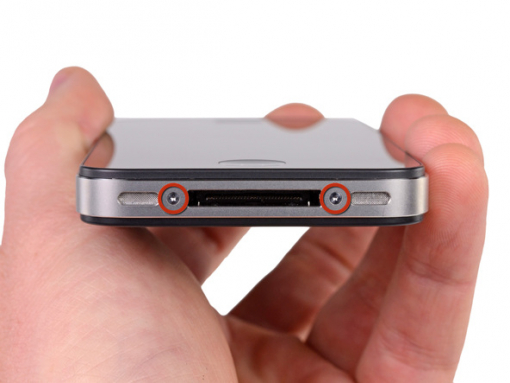iPhone 4S Screen Replacement
Step 1 - Rear Panel
Prior to disassembling your iPhone, make sure to turn it off.
Two 3.6 mm Pentalobe screws next to the dock connector need to be removed
While assembling the phone again, we suggest you to replace the 5-point screws with equivalent Phillips screws.
The 5-Point Screwdriver is meant to be used only once, as it may strip the screws.


Step 2
Press the back panel and push it towards the top edge of the iPhone.
Back panel will move about 2 mm.
Step 3
Separate the back panel from the back of the iPhone, and make sure not to damage the plastic clips fixed to the back panel.
Remove the back panel from the iPhone.
Step 4 - Battery
Back to top
These screws securing the battery connector to the logic board need to be carefully removed:
One 1.7 mm Phillips screw
One 1.5 mm Phillips screw


Step 5
With a help of plastic opening tool, you need to pull the pressure contact which is positioned below the battery connector.
When the pressure contact is being reinstalled, it needs to be cleaned with a degreaser such as windex or isopropyl alcohol. The natural oils on your fingers may accidentally create wireless interference.
Carefully separate the battery connector from its socket on the logic board by using the edge of a plastic opening tool.
Make sure only to raise the battery connector and not the connector on the logic board. If you push the logic board connector, it may happen to completely break the connector.


Step 6
Place the edge of a plastic opening tool between the battery and the outer case close to the lower left corner of the iPhone.
Move the plastic opening tool along the right edge of the battery and gently push at several points to entirely separate it from the adhesive securing it to the outer case.


Step 7
Exposed clear plastic pull tab will allow you to peel the battery off the adhesive securing it to the iPhone.
Remove the battery.


Step 8 - Speaker Enclosure Assembly
Back to top
These screws fixing the dock connector cable cover to the logic board need to be removed:
One 1.5 mm Phillips screw
One 1.2 mm Phillips screw
Remove the metal dock connector cable cover.
Step 9
The dock cable needs to be lifted up from its socket on the logic board using the edge of a plastic opening tool.
Step 10
Dock connector cable needs to be peeled off the adhesive securing it to the logic board and the side of the speaker enclosure.


Step 11
Gently separate the cellular antenna cable from its socket on the logic board using the edge of a plastic opening tool.
Pull the cellular antenna cable out from beneath the metal fingers fixed to the logic board.
Step 12
Take out the two 2.4 mm Phillips screws fastening the speaker enclosure assembly to the outer case.



Step 14
Carefully lift the speaker enclosure assembly out of the case using the plastic opening tool, paying attention not to damage the EMI fingers on the attached Wi-Fi antenna.
Remove the speaker enclosure assembly.
Prior to reinstallation of the speaker enclosure assembly's screws, check if the Wi-Fi grounding fingers are installed below the lip in the iPhone's metal case as shown in the third picture.
Prior to reassembly it is necessary to clean all metal-to-metal contact points between the grounding fingers of the Wi-Fi antenna and the case of the iPhone using a de-greaser such as windex or isopropyl alcohol. The natural oils on your fingers may accidentally create wireless interference issues.
Step 15 - Screen
Back to top
You need to remove the small pieces of black tape that covers the screen supporting tabs.


Step 20
You need to loosen the three large-headed Phillips screws placed along the side where the volume button is, for about 1/2 turn.
There is no need to completely remove these three screws. When reinstalling the screen, make sure the rings are closest to the screw head (See the second picture).
Step 21
You need to loosen the three large-headed Phillips screws placed along the other side of the iPhone, for about 1/2 turn.


Step 22
With the edge of the opening tool gently lever the screen around its perimeter.
Remove the screen from the iPhone.
When re-assembling the screen, make sure that the digitizer and screen data cable are pulled all the way through the slot cut into the outer case. If not, the digitizer cable will not extend to its socket on the logic board.
Do not forget to move the home button from your old screen to the new one since it not provided in most cases. Also check that the connector for the speaker hole is provided present in the replacement; if not, switch it over from the old screen.
After you finish the reassembly, we suggest you to apply a new screen protector in order to protect your screen from scratches.



























